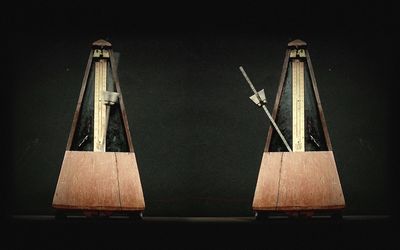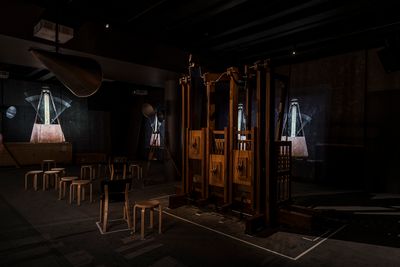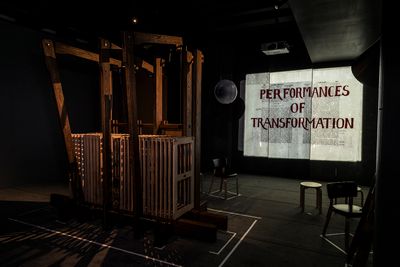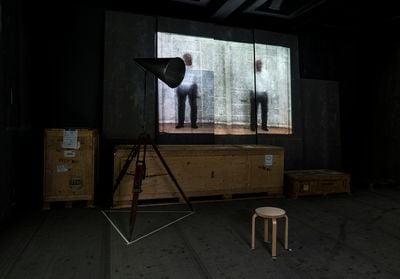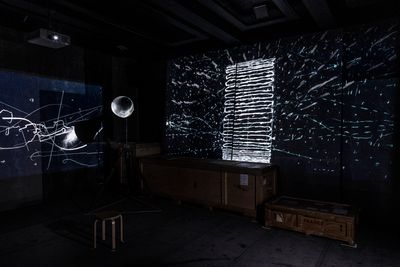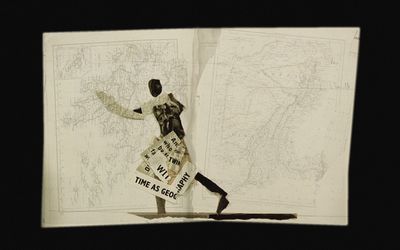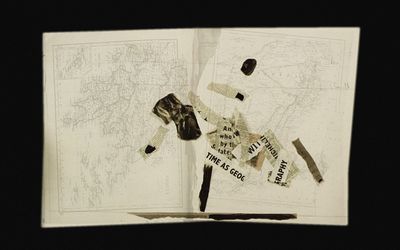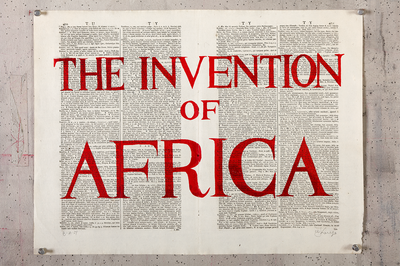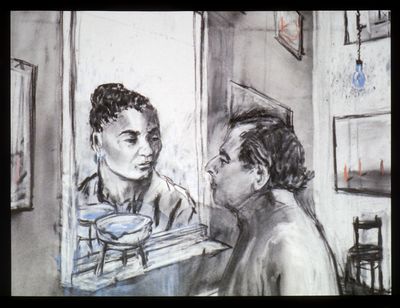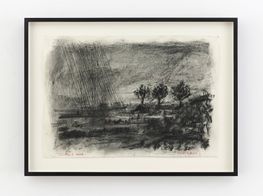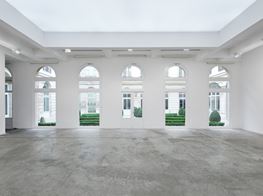William Kentridge
William Kentridge. Photo: Stella Olivier.

William Kentridge. Photo: Stella Olivier.
For over 20 years, the legacies of colonialism have been recurring themes in William Kentridge's work. In 2018, he was awarded an honorary doctorate degree from the University of Pretoria in South Africa in recognition of a practice that has consistently charted 'a universal history of war and revolution, evoking the complexities and tensions of postcolonial memory and imaging the residual traces of destructive policies and regimes.'1
Since 1989, Kentridge has utilised stop-motion animation, film, performance and sculpture to depict the sociopolitical condition of his native post-apartheid South Africa. His works have been exhibited widely, including solo shows at the Museo Nacional Centro de Arte Reina Sofía in Madrid (Enough and more than enough, 1 November 2017–19 March 2018), Whitechapel Gallery in London (Thick Time, 21 September 2016–15 January 2017), the Museum of Modern Art in New York (Five Themes, 24 February–17 May 2010), and the National Museum of Modern and Contemporary Art, Korea, in Seoul (Peripheral Thinking, 1 December 2015–27 March 2016). This summer at the Tate Modern in London (11–15 July 2018), Kentridge presented The Head & the Load (2018), a multidisciplinary performance that combined music, dance, film projections, mechanised sculptures and shadow play to create an imaginative landscape telling the untold story of the hundreds of thousands of African porters and carriers who served in British, French and German forces during the First World War.
The exploration of the concept of time—how we mark its passage, how it shifts our intuitions, and how it relates to complex legacies of colonialism—is at the centre of Kentridge's five-channel video installation, The Refusal of Time (2012). First conceived as a commission for dOCUMENTA (13) (9 June–16 September 2012) and currently on view at Kunsten Museum of Modern Art Aalborg until 19 August 2018, the installation grew out of conversations between Kentridge and Peter L. Galison, and encompasses sound, drawings, text, film, sculpture, and performance. The opening sequence features metronomes across the five screens, beating out the timing for the work like a pulse or heartbeat in synchronicity. But this anchoring is soon lost as the screens proceed to flicker with a continuous flow of moving images featuring: Kentridge's signature stop-motion charcoal animations; repetitive live-action sequences such as the artist climbing over a chair giving the illusion of motion; there are books and pages with various unrelated phrases; there is a section representing the blowing up of the meridian where a dancer, Dada Masilo, dances around flying pieces of paper invoking a collapse of order; and similar blown-up pieces of paper reconstruct into coffee pots, animals, and the human body.
Accompanying these images is a collage of sounds played from megaphones and composed by Philip Miller, of Kentridge performing readings such as Counting Time (2012) or How Do We Know We Are In Time? (2012). The installation also features a sculptural component of a moving wooden sculpture—which Kentridge calls 'the elephant'—that expands and contracts as if breathing in and out or pumping air up and down in a steady rhythm. At times it seems like this movement is controlling the sounds and images on screen, and in other moments, bearing witness to them. Throughout, Kentridge physically plays with time by reversing or speeding up the clips and sounds, rendering it impossible to follow a cohesive narrative.
The Refusal of Time is also about human experience and fate, and through fracture and fragmentation the piece disrupts the ubiquity of time as a means to regulate bodies. It references the year 1884, when Greenwich Mean Time (GMT) was established as the standard measure of time independent of location. Martial Bourdin, an anarchist living in London, attempted to blow up the Greenwich Observatory in 1894: a decision, as Galison explains, that represented an attack on the supposed neutrality of time: the 'zero time' of longitude, and the centre of the colonial order.2
Time, in fact, was imposed on many cultures as a necessary component of colonisation, deployed to save the 'others'. In 1905, Albert Einstein would declare that there was no single time, but instead multiple times, upsetting many who felt that their intuitions had been shattered. Einstein added that our intuitions are, in fact, historically determined and constantly changing—just like our physical bodies. In the work, this inevitability is conveyed towards the end of the video projection through a procession of shadow figures marching from screen to screen towards a black hole. Thus, in The Refusal of Time, the notion flows back and forth between history, art, and science—a circulatory process that both Galison and Kentridge encouraged when making and thinking about the work.
In this conversation Kentridge discusses time and fragmentation with The Refusal of Time as the centrepiece.
KMI spent the last few weeks scouring the internet for your work, specifically information about your five-channel video installation The Refusal of Time (2012). I quickly found myself in a black hole, attempting to chronologically map out your projects, realising the enormity of this task as similar—or at times the same—images jumped from one work to the next. Mixed-media animations, which make up sections of your larger multi-channel projects, would extend and reappear as background visuals for your lecture performances, and ideas seemed to endlessly fold and unfold from screen to screen.
As such, I thought I would start off by asking you to talk about how The Refusal of Time came together? Where and how do you begin to deconstruct a concept as large as time? Which or whose time do you use as an entry point into your exploration? What is being refused?
WKFor every project there always has to be two things that come together. A broad theme that is broader than the project, and a material in which to think of the theme. The project for The Refusal of Time started by thinking of an image of space not being empty, but filled with images of everything that has happened on earth, moving out at the speed of light. We know that when we see a distant star, we are seeing that star as it was a billion years ago. So theoretically, obviously aligned with perfect optics, if you're at that distance from the earth, you would see life on earth a billion years ago; or if you were that much closer you might see something on earth four hours ago or 20 years ago. This idea of space being densely filled with this infinite number of specific images coming out from the world was one starting point.
At first, I thought The Refusal of Time, as a whole, would be a projection on a ceiling, where one could see this myriad of images—and of course there's an echo with the internet and the images in the cloud, with images travelling through space. Then I decided that I needed a scientist to work with and was recommended Peter Galison, whose field of expertise—among many of them—was the prehistory of the theory of relativity in which the storage of the speed of light in these images traversing out from earth were a part. It was in the conversations with Peter about the idiosyncratic ways in which time had been thought about and dealt with that the project latched on to time as a theme. Then, the conversation really had to do with me thinking about how one might turn that into material, or through which material one could think about the theme. That material became two things: film and music.
The composer Philip Miller was brought in very early to these discussions about how music, which is a time-based medium, could become a medium to think about time. One can do it by reversing music, by slowing it down, repeating, and stopping—as one can do with film, which can turn time into a very concrete object. And so it was through these ways of thinking that we organised workshops with musicians, and Galison was there talking to us. We worked with costume designers, made objects, tested time delays with wind instruments, and gradually found a range of words and verbs that would become our vocabulary for making the piece—words and verbs and sound and image.
Finally, towards the end, Philip Miller explained to me that the lectures Peter and I had been giving to the company to explain these ideas in fact would inform the libretto and that, like it or not, I had to perform in the piece.
KMTime as a theme seems to run through many of your moving image works; at points it's conceptually at the forefront and in other cases it's conveyed technically by speeding, breaking, or reversing clips. Can you elaborate on the role that the concept of time plays in your practice and your relationship to it? Is time something that you find yourself grappling with constantly? How is time reflected in your other works?
WKIt's not as if I started off by thinking: I have good ideas about time, let me talk about time. It was rather, that if you work with charcoal animation where you are continuously drawing and redrawing an image and leaving a trace behind of the previous image that was erased, you discover that what you have on the sheet of paper is an accumulation of time—time in charcoal dust. And whether you like it or not, the work becomes about holding onto this materiality of time, which, jumping one step further, is obviously going to be about memory—either personal memory, historical memory, or the fleetingness of memory; because there are ways that the paper, out of necessity and through the very medium of drawing itself, holds the memory in a stronger way than the world does. I move my arm from A to B. When it has reached B there is no trace of it. But if I do an animation of that process, the whole history of that movement is contained in images, smudged and erased on paper. So, the question of time and memory and history was built into the technique, and was a result of the technique rather than the technique being a way of illustrating or even thinking about an idea.
KMAs a whole, your work resists offering any linear narratives. Instead, meaning is to be found through the juxtapositions of sound, language, images, and ideas. In The Refusal of Time there are very few moments of coherence except at the beginning of the video with the steady beating of metronomes, when fragmented images come together for a moment to form a cohesive picture only to collapse again; then at the end of the work, with the inevitable procession towards a black hole. For me, this has some relation to Walter Benjamin's ideas of using collage and montage as principle forms to talk about history and the present.
Could you talk about the importance of collage as a methodology in your practice and how you are able to offer meaning through fragments and chaos?
WKIt seems to me that collage, at least for the last 100 years, has been the technique that most accurately describes our world. It's very difficult to do that through text, but very easy and natural to do it in the visual arts. One has to understand that when one goes through the world presenting a coherent façade, or when one writes a description of an event as a coherent single thing, what one is doing is taking millions of fragments and constructing a fiction of possible coherence.
We understand, certainly from Freud onwards, that our psyches are completely fractured and made of many different and sometimes competing and conflicting elements, and that if we present a benign, calm façade to the world that speaks in coherent sentences and has a coherent idea, there is a construction over many different fragments that go through it. Thinking about the way of understanding the world in the studio, it is very natural to use fragments—to have pinned on the wall yesterday's drawings, postcards, emails, and newspaper cuttings. This is the natural world of an artist in their studio, which has been fractured as it comes into the studio; it is rearranged in a painting, a song, a piece of work, and then sent back out into the world as a possible coherence.
The idea of collage seems to me to be the most accurate and naturalist description of the necessity we have of making sense of the world by taking different fragments and putting them together as if there is coherence. It is about understanding that the jug that seems perfect is in fact shattered and then constructed out of shards into what appears to be this beautiful and perfect jug. Sometimes, it's good to show all these different fragments for people to understand the nature of the jug itself.
KMYou've talked about the notion of entropy as a tendency for order to dissolve into disorder. You've also referred to it as the breakdown of something that starts as a coherent thought or object that is fully intact and that gradually disintegrates, becoming something fragmentary. But entropy is not just destruction and chaos. To borrow from Michelle Wright, entropy may well be the best conceptual prism through which to understand time's passage as expansive rather than linear and only ever moving forward.3 Entropy allows for a break in conventionally linear histories, allowing other voices to enter this timeline.
You use the phrase 'Anti-Entropy' in a number of different works—it's the principle image in Anti-Mercator (2010–2011), reappears in The Refusal of Time; and is also part of the 'Rubrics' series (2012), which is comprised of 14 red silkscreen texts, printed on vintage books. 'Anti-Entropy' is also the title of the sixth and final drawing lesson that was part of your Charles Eliot Norton lecture series from 2012 at Harvard University.
Could you expand on what you mean by 'Anti-Entropy'? Where does it come from?
WKI use it in different forms and it is a theme that comes back. At the moment I'm very interested in the 'Markov blanket'. The Markov blanket is a mathematical term that has come in to biology and artificial intelligence to describe the membrane that is the limit, primarily, I suppose, of a living being. What is it that determines the edge of me and the beginning of everything else in the world? On the one hand, the membrane has to hold a coherence inside it, but it also has to respond to the world outside. For example: internally I'm a coherent person but I'm responding to the world outside when it's cold and by knowing that if I want to survive, I must warm myself up. If it's too hot I know I must get into a cooler place—these are basic activities, which are anti-entropic, that resist entropy, and which enable life or the coherence of a self to exist. Instead of everything dissolving, there must be this active effort of making sense and finding a condition of life.
One way of describing what makes something alive—from whatever its size, from an amoeba to anything else—is that it resists the tendency to cool down, lose energy, to go from one state of order to disorder, for the human body to turn to dust. It is anti-entropic. We know that's a tendency going on, and that we have to resist it both biologically and psychically. So, when we throw a jug up in the air and it shatters, entropy declares statistically how unlikely it is that if we throw those shards into the air they will land back into the form of that same jug. But if you take all the shards that have been shattered, the artist's job is to construct these shards, if not into the first jug, then into another jug. To describe another understanding of the world is an act of resisting entropy.
The idea of other voices coming into the narrative through entropy, that's a different take and it sounds interesting—that's very different to what I've been thinking about. If it's about entropy seen as a kind of exhaustion, of a master canonical narrative to allow other voices in, then it does make sense—one would hail the anti-entropy of those other voices that are forcing their way through to be heard.
KMI read the refusal as that which re-emerges as ghosts that refuse to be silenced. There is something allusive, elusive, and illusive in your works that keeps coming back to haunt the present. This of course is built into your technique of drawing and erasing, where one drawing is altered hundreds of times on the same sheet of paper. In this way, there is always a trace of what was there before: what was erased, suppressed, or forgotten.
Could you talk about ghosts and spectres in your work? I'm thinking specifically about the spectre of colonialism and apartheid and how the impact of both hover over your practice, even though they aren't central themes.
WKAt the moment I'm working on a project about Africa and World War I, which is a historic piece in some senses, but it's also very much about questions of colonialism. Questions of colonialism and decolonisation are very pertinent in current political debates in South Africa at the moment. Universities are closed over debates about how to tackle this, how to make sense of the colonial past. For me, the First World War encapsulates, compresses, and heats to a certain temperature all the paradoxes and contradictions of colonialism. Some African elites are saying, 'We demand the right to go and fight and die for France and Britain', and other people are saying, 'Why on earth should we go and die for the sake of Germany and France, which have only been destructive to us?' These opinions are often expressed by the same person, which is what I mean when I describe the deep paradox of what colonialism is, and what the questions of colonialism are. But these issues feel current; they don't feel like ghosts. With the spectre of apartheid in South Africa, we're dealing very much with colonialism's continuation and ongoing questions of extreme privilege and extreme depravation.
KMYou reference the landscape in relation to the body in many of your works. For example, Felix in Exile (1994), 'Colonial Landscapes' (1995–1996), and Johannesburg, 2nd greatest city after Paris (1989), all deal with violence, trauma, memory and the healing of the South African landscape. There appears to be an obsessive action of drawing, erasing and redrawing the landscape throughout your practice. Could you talk about the relationship in your work between the landscape, history, memory, forgetting, and the human body?
WKWell, in its most basic form, it's clear that a landscape forgets what's happened in it. In the most banal sense, if you cut your lawn, then two weeks later that lawn has forgotten its haircut—the grass has grown back and so it's hard to find a trace of that cut. In a larger sense, you have an area in a forest in which a massacre took place, but the traces of that have grown over and you have to look for clues in the landscape. They're not there; you have to find them—to find a newly planted row of trees that suggests where a mass grave is. So the landscape itself both holds its memory but also hides it. It's there deeply, usually to be re-found; and there's a kind of regret in something that should be so obvious being so hidden and so disappeared. That's the same feeling one has about human memory, which one often regrets—that it's so fleeting. One understands that there is a very narrow band of memory in which we can survive. If we forget everything, as in a kind of dementia or Alzheimer's, it's very difficult to function in the world. But if we remember everything we're also paralysed by trauma, by memory.
Everyone has memories that are violent, or others that we wish we would not hold on to because it's very easy to be completely consumed by them if there's no way for them to fade over time. Something that seemed intolerable just over an hour ago, may give you an occasional pang by next week—it doesn't drive you crazy at three in the morning as it did the first night. There's a parallel sense in the need for forgetting, both historical and personal, and that's what a landscape does, where regret and need are both present. In many ways, the relationship between the human body and the landscape feels fairly close to me, both in the sense of the work that is done on the landscape, from its defacement and construction—a bit like the changes that can be affected on a person.
KMOften when people speak about Africa it's through the lens of European history. Time also seems to stand still when describing Africa, which of course is a result of it having always been described from the outside. For some, it is a utopian space that one can return to in order to access a utopian past; for others, Africa remains something crude and in need of taming. But for those of us who were born and raised on the continent, Africa resists articulation through language.
How does Africa enter your studio and what does it mean to be an African artist beyond race?
WKThis is a hard question that I don't have a clear answer to. I realise that even though a lot of my work has been based on European classics—Wozzeck, Faustus, Ubu—they're all inflected through what it is that they're made of in South Africa, with local performers and Johannesburg material. It seems that all of Africa, whether we like it or not, is so caught up in this question of its history, certainly in the last few hundred years, which is its relationship to Europe—America, too, the far East a little bit, but largely to Europe.
I'm very wary of continental descriptions. Africa's been invented several times, but almost always, as you say, from the outside. There have been political pan-African movements, but we understand these to have been a pan-Africanist description of local movements rather than a real belief that all of Africa is one unified thing, or that there is an African essentialism. If there is an essentialism in Africa it absolutely has to do with its bastard nature and mixtures of different histories, trajectories, traditions, cultures; no more so than in South Africa and no more so in South Africa than in Johannesburg, which is entirely made up of these mixed traditions and ways of seeing and understanding the world.
I think that in order to understand contradiction, absurdity, paradox, and provisionality, Africa is not so different to other parts of the world, but often these elements are visible in heightened forms. I'd be wary to say that's a specifically African characteristic, but it is certainly one of the things that throws itself forward when you're looking at South African history and colonial histories further afield. In terms of deep African history and the great kingdoms of the Middle Ages, those feel much further away to me; as much as the great kingdoms of the Tartars or the Russians feel very far away. —[O]
—
1 Vasu Reddy, 'Artist William Kentridge Gets Honorary Doctorate from UP', The Citizen, 13 April 2018: citizen.co.za/news/south-africa/1892369/artist-william-kentridge-gets-honorary-doctorate-from-up-2/.
2 Peter Galison, 'Time Art Science', Harvard University, 1 June 2012: galison.scholar.harvard.edu/art-collaborations.
3 Michelle P. Wright, 'The Physics of Blackness', Artforum: www.artforum.com/print/201506/the-physics-of-black-art-52255




